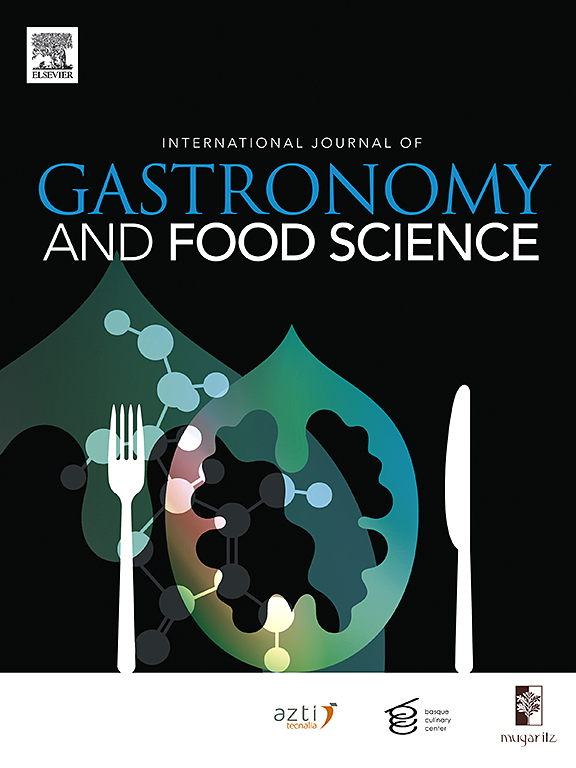Gender stereotypes and perceptions of age in food: A comparative analysis between Spain and Ecuador using the product personality profile technique
IF 3.6
2区 农林科学
Q2 FOOD SCIENCE & TECHNOLOGY
International Journal of Gastronomy and Food Science
Pub Date : 2025-05-28
DOI:10.1016/j.ijgfs.2025.101213
引用次数: 0
Abstract
Eating behavior possesses significant symbolic and social dimensions, reflecting individual identity and influencing social interactions. The study examines the prevalence of gender stereotypes and ageism within consumer perceptions across two distinct cultural contexts: Spain and Ecuador. A projective technique based on the Product Personality Profile (PPP) was used. The findings revealed statistically significant associations related to gender and age across food samples. In the Spanish context, the Fruit Bowl (FB), Caprese Salad (CS), and Iron (I) were predominantly aligned with feminine attributes.
In contrast, Cold Meat (CM) and Meat with Vegetables (MV) were traditionally associated with masculinity. In Ecuador, gender associations exhibited some similarities, with minimal representation of non-binary identities. Age-related analysis indicated that, in Spain, food items such as the FB and W were frequently associated with middle-aged (18–44), while CM and MV were linked to older people. Ecuadorian participants primarily associated all food types with the middle-aged group (18–44). Factor Correspondence Analysis (FCA) supports gendered food stereotypes: vegetables, fruits, and sweets were linked with femininity, while meat was linked to masculinity. These findings align with past research highlighting culturally reinforced food gender stereotypes. These findings contribute to understanding how food perceptions reflect social norms and transformations in multicultural settings.

性别刻板印象和对食物年龄的看法:西班牙和厄瓜多尔之间使用产品个性特征技术的比较分析
饮食行为具有重要的象征维度和社会维度,反映个体身份,影响社会互动。该研究调查了西班牙和厄瓜多尔两种不同文化背景下消费者观念中普遍存在的性别刻板印象和年龄歧视。采用基于产品个性特征(PPP)的投影技术。研究结果显示,在食物样本中,性别和年龄之间存在显著的统计学关联。在西班牙语境中,水果碗(FB)、卡普瑞斯沙拉(CS)和铁(I)主要与女性特征相一致。相比之下,冷肉(CM)和蔬菜肉(MV)传统上与男子气概有关。在厄瓜多尔,性别联系表现出一些相似之处,很少有非二元身份的代表。与年龄相关的分析表明,在西班牙,像FB和W这样的食物通常与中年人(18-44岁)有关,而CM和MV则与老年人有关。厄瓜多尔的参与者主要将所有食物类型与中年人(18-44岁)联系起来。因子对应分析(FCA)支持性别对食物的刻板印象:蔬菜、水果和糖果与女性气质有关,而肉类与男性气质有关。这些发现与过去的研究一致,强调了文化上强化的食物性别刻板印象。这些发现有助于理解食物观念如何反映多元文化背景下的社会规范和转变。
本文章由计算机程序翻译,如有差异,请以英文原文为准。
求助全文
约1分钟内获得全文
求助全文
来源期刊

International Journal of Gastronomy and Food Science
Social Sciences-Cultural Studies
CiteScore
5.30
自引率
10.50%
发文量
170
审稿时长
45 days
期刊介绍:
International Journal of Gastronomy and Food Science is a peer-reviewed journal that explicitly focuses on the interface of food science and gastronomy. Articles focusing only on food science will not be considered. This journal equally encourages both scientists and chefs to publish original scientific papers, review articles and original culinary works. We seek articles with clear evidence of this interaction. From a scientific perspective, this publication aims to become the home for research from the whole community of food science and gastronomy.
IJGFS explores all aspects related to the growing field of the interaction of gastronomy and food science, in areas such as food chemistry, food technology and culinary techniques, food microbiology, genetics, sensory science, neuroscience, psychology, culinary concepts, culinary trends, and gastronomic experience (all the elements that contribute to the appreciation and enjoyment of the meal. Also relevant is research on science-based educational programs in gastronomy, anthropology, gastronomic history and food sociology. All these areas of knowledge are crucial to gastronomy, as they contribute to a better understanding of this broad term and its practical implications for science and society.
 求助内容:
求助内容: 应助结果提醒方式:
应助结果提醒方式:


